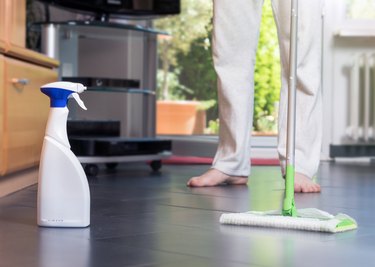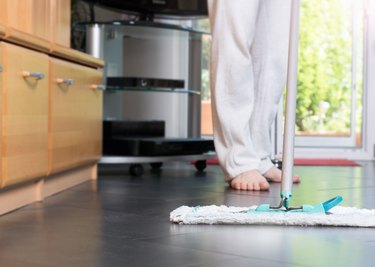
With proper care, a real linoleum floor can last several generations, which makes it an excellent flooring option for rooms that aren't subjected to excessive moisture or humidity. Proper care also includes proper washing: Linoleum flooring is durable, but could degrade a bit under exposure to some types of floor cleaners, especially those with high alkalinity.
Genuine Linoleum Is Not Vinyl
Video of the Day
Genuine linoleum flooring is not only durable; it's eco-friendly and naturally resists bacteria, mold and mildew. It's made from mixture of natural materials including linseed oil and substances such as jute, tree resins and powdered forms of cork and wood. Caring for a real linoleum floor is much like caring for a hardwood floor: A damp mop is often enough to do the trick, but too much moisture can cause damage.
Video of the Day
Vinyl flooring, which is sometimes incorrectly called linoleum, shares no traits with true linoleum at all, other than the fact that it's a durable floor covering. Vinyl flooring material is a sheet of vinyl made from several layers. On the bottom is the base layer; some versions include an underlayment that cushions the flooring a bit. In the middle is an image layer that contains a solid color or a pattern, and in some cases, a slight texture. The top layer is a durable sealant that makes the vinyl waterproof.
Before Washing the Floor
Whether you use your a pre-made linoleum floor cleaner or make your own, the floors must be free of dust and debris first. This helps prevent scratches that could occur if, for instance, a small bit of gravel becomes trapped in a wet mop as you wash the floor.
First, sweep the floor with a broom, then use a dust mop or a vacuum cleaner designed for hard floors. A combination of techniques also works well, as a broom and dustpan are ideal for cleaning up crumbs and bits of tracked-in dirt, while a dust mop cleans up dusty corners and areas beneath furniture.
For best results, dust the floor every day or two and sweep as needed when you spot crumbs or other visible debris on the linoleum.

Routine Care with Store-Bought Cleaners
Not just any off-the-shelf floor cleaning product will do for a linoleum floor. Flooring manufacturers recommend pH-neutral cleaning products, especially those specifically formulated for linoleum. General floor cleaning products or multi-purpose cleaners may be too harsh for linoleum, either dulling or damaging its surface. Ammonia in particular is too harsh and should never be used, as this could strip the finish from the linoleum.
Wash the floor once or twice a week, or as needed.
- Add 1 gallon of water to a bucket, along with 1/4 cup or so of the linoleum cleaner, as directed on the label.
- Dip a clean mop into the bucket, wring out most of the water, then mop in relatively small sections at a time, such as a 6-foot-by-6-foot area.
- Continue until the entire floor has been mopped or the water looks a little dirty. If the water gets dirty, dump it in the sink and start with a new batch of water and the linoleum cleaner.
- Rinse the mop and bucket thoroughly. Fill the bucket with fresh warm water, then mop the floor again with a slightly damp mop.
- Dry the floor either with old towels or by turning on fans. If you see any standing water, sop it up with an old towel, as standing water can harm the linoleum.
Homemade Linoleum Cleaner
There's no need to buy a linoleum-specific cleaning product as you long as you wash the floor with gentle ingredients and minimal moisture. A solution consisting of a squirt or two of dish soap per gallon of warm water does the trick for light daily or weekly cleaning—just be sure to wring the mop out thoroughly before washing the floor. Wipe the floor down again with a mop dipped into a bucket containing only water. Again, the mop should be damp, not wet. Dry the floor with old towels or let it air dry, only using towels for areas that need it.
For deep cleaning or if the floor has a waxy buildup, try 1 cup white vinegar per gallon of warm water, along with a few drops of dish soap. Sprinkle baking soda lightly over the floor, then mop the floor. Mop again with just water, then air or towel dry the linoleum. This vinegar solution also helps remove greasy spots or spills.
Removing Shoe Marks and Scuffs
Where shoes or furniture move across a linoleum floor, scuffs can happen. Opt for gentle methods first. Rub the scuff with a gum eraser or pencil eraser first; the friction often lifts the scuff off the floor. A melamine foam eraser designed for cleaning also excels at removing scuff marks. Wet a corner of the foam, then rub the spot.
If any part of the scuff remains, mix a little baking soda with just enough water to make a paste. Apply the paste to the mark, then rub it with an old rag or dishcloth. Wipe the paste residue away with a clean damp cloth. For stubborn residue, try buffing the spot with a dab of baby oil or another water-displacing liquid on a rag. Wipe the area with a damp cloth afterwards, then a dry cloth, to remove any oily film.
Tough Spots and Stains
Linoleum is prone to staining, so it's best to wipe up spilled foods and drinks right away. Rubbing alcohol is the secret last-resort weapon for difficult-to remove spots after you've tried gentler methods. Pour a little rubbing alcohol onto a folded white rag. Avoid using red shop towels, as the dye may transfer onto the linoleum. Place the wet part of the rag over the stain and let it sit for at least 10 minutes. The alcohol should lift the stain. If the problem spot also contained sticky residue that hasn't come up, rub it with a nylon kitchen scouring pad. Wipe the area down with clean water, applied with a damp cloth.